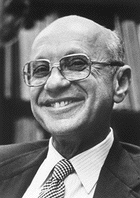| Profile | Major Works | Resources |
Milton Friedman, 1912-2006


One of the most highly influential economists, political commentators and essayists of the century, Milton Friedman is one of the best known economists known to the general public in recent decades. An ardent opponent of the Keynesian economics, Friedman led the "Monetarist" incarnation of the Chicago School against the Keynesian orthodoxy in the 1960s and early 1970s. (click here for our Survey of Monetarism)
Born in Brooklyn to Romanian parents, Friedman studied at the University of Chicago as an undergraduate, wrote an empirical master's thesis under Henry Schultz and then proceeded to Columbia University for doctoral work. Under the wing of Harold Hotelling, James Angell and Wesley Mitchell, Friedman was launched as an empirical economist, focusing on mathematical statistics and business cycles. Friedman became a member of Mitchell's NBER in 1937 and served for a few years on Hotelling's Statistical Research Group during the war. Abraham Wald, who was also on the SRG, credits Friedman as an inspirer of his "sequential design" system of statistical inference. His empirical work with Simon Kuznets (1945) set the stage for his later contributions to consumption theory. Friedman obtained his Ph.D from Columbia in 1946 and got an appointment at the University of Chicago that same year.
Friedman's early contributions include his formulation of risk-aversion and risk-proclivity (1948, with L.J. Savage), his use of evolutionary theory in the theory of the firm (1953), his controversial propositions for a "positivist" methodology in economics (1953) and, perhaps most fundamentally, the "Permanent Income Hypothesis" in consumption theory (1957).
Friedman's important criticisms of Keynesian theory began with his attack on the IS-LM dichotomy in his "restatement" of the Quantity Theory in 1956 -- effectively, reminding Keynesians that "money matters". This was followed up by a massive historical study with Anna J. Schwartz on the Monetary History of the United States (1963) - leading to a famous debate on money-income causality. In his famous presidential address to the American Economic Association, Friedman (1968) then focused his attention upon the apparent breakdown of the Phillips Curve relationship in the 1970s. He proposed to replace it with a "Natural Rate of Unemployment" (NRU) - a concept later formalized in more detail by the New Classicals.
Friedman wrote much on various aspects of economic policy. In general, he argued that government discretionary "fine-tuning" of the economy, as had been proposed by Keynesians, ought to be replaced with iron "rules" of policy - notably his famous "money supply growth" rule (1959).
Milton Friedman has also been a widely-read advocate of laissez-faire economic policies, particularly stressing the linkage between free markets and liberal democracy which has come to characterize the "Neo-Liberal" (or "Neo-Conservative" for Americans) movement that gained ground particularly in the 1980s. He was a founding member of the Mont Pelerin Society organized by Friedrich Hayek in 1947. Friedman's regular columns in Newsweek (1966-1984) and his best-selling popular volumes (e.g. 1962, 1972, 1980, 1984) have made him quite a celebrity. His political involvements have made him a lightning rod for both critics and advocates of "neo-liberalism". He was an adviser for Barry Goldwater in 1964, Richard Nixon in 1968 and Ronald Reagan in 1980. The British Prime Minister Margaret Thatcher credited Friedman with inspiring many of her reforms.
However, Friedman's role as an economic advisor to the Chilean military dictator, Augusto Pinochet, in the mid-1970s, earned him much criticism, from foes and friends alike, arguing that he had betrayed his support of political freedom by cooperating with such an unsavory regime. Friedman's response was that it was entirely consistent: free markets, he claimed, are a pre-condition and indeed, a catalyst for democracy and credits precisely the liberalization of markets he helped engineer for the subsequent democratization of Chile.
Friedman won the Nobel Memorial prize in 1976. He retired from the University of Chicago and has, since 1977, been a fellow of the Hoover Institution at Stanford University. He continued to be actively involved in debates on economic theory and policy up until his death in 2006.
|
Major Works of Milton Friedman
|
HET
|
|
Resources on Milton Friedman
|
All rights reserved, Gonçalo L. Fonseca
